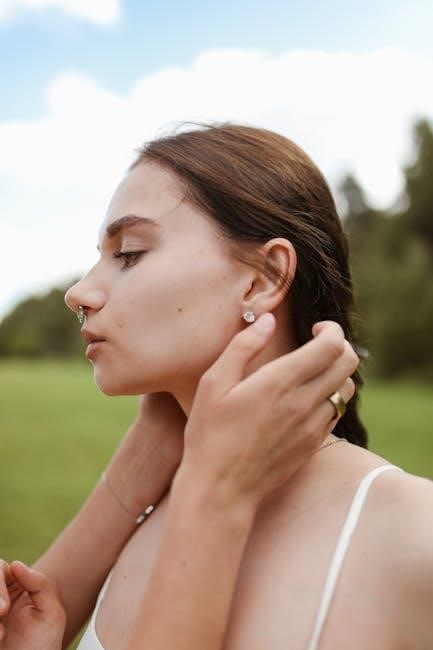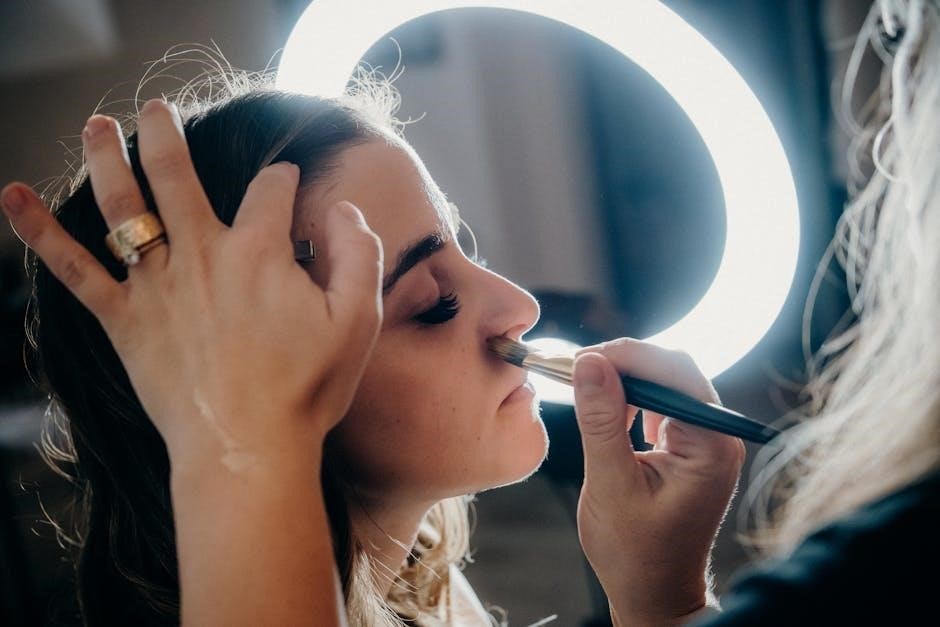Understanding nose ring sizing is crucial for both comfort and style. It involves determining the right gauge (thickness) and diameter (size) to ensure a perfect fit and desired appearance.
Importance of Proper Sizing for Comfort and Appearance
Proper nose ring sizing ensures both comfort and a flattering appearance. A gauge that is too thick may cause discomfort, while one too thin can look unnatural. The diameter must also be appropriate to fit the piercing without causing irritation or swelling. Choosing the correct size enhances the overall aesthetic, making the jewelry complement the face shape and piercing. Incorrect sizing can lead to discomfort or an unflattering look, emphasizing the need for accurate measurements and consideration of personal preferences when selecting a nose ring.
Understanding Nose Ring Gauge Sizes
Understanding nose ring gauge sizes is essential for comfort and style. Gauge refers to the thickness, with lower numbers (e.g., 16G) being thicker than higher numbers (e.g., 20G). Common sizes include 18G (1mm) and 20G (0.8mm), often used by piercers to accommodate swelling, ensuring a comfortable and visually appealing fit.
Nose Ring Gauge Size Chart
A nose ring gauge size chart helps determine the thickness of the jewelry. Common gauges include 14G (1.63mm), 16G (1.3mm), 18G (1mm), 20G (0.8mm), and 22G (0.6mm). Lower gauge numbers indicate thicker jewelry, while higher numbers mean thinner pieces. The chart is essential for selecting the right size, ensuring comfort and proper fit. Most piercers recommend starting with a slightly larger gauge (e.g., 16G) to accommodate swelling during healing. This ensures the jewelry sits comfortably and looks appealing. Use the chart to match your piercing needs and personal style preferences.
How Gauge Size Affects the Thickness of the Jewelry
Gauge size directly impacts the thickness of the nose ring. A lower gauge number means a thicker piece, while a higher number indicates a thinner one. For example, a 14G nose ring is 1.63mm thick, while a 22G is 0.6mm. Thicker gauges are more noticeable, while thinner ones are more subtle. Choosing the right gauge ensures comfort and aesthetic appeal, balancing durability with the desired visual effect. This measurement is critical for both functionality and personal style preferences.
Common Gauge Sizes for Nose Piercings
The most common gauge sizes for nose piercings are 18G (1.0mm) and 20G (0.8mm). These sizes are widely used due to their balance between comfort and visibility. Piercers often start with a slightly larger gauge, such as 16G (1.2mm), to accommodate swelling during healing. Thicker gauges, like 14G (1.63mm), are less common but offer durability. On the thinner side, 22G (0.6mm) is available, though professionals typically advise against it due to potential discomfort and fragility.
Nose Ring Diameter Sizing
Diameter refers to the inner measurement of the nose ring, typically ranging from 6mm to 10mm. Standard sizes include 8mm, which is the most common choice for comfort and aesthetics.
Standard Diameter Measurements for Nose Rings
The standard diameter for nose rings typically ranges from 6mm to 10mm, with 8mm being the most common size. This measurement refers to the inner circle of the ring and is crucial for ensuring comfort and proper fit. A smaller diameter, such as 6mm, creates a more delicate appearance, while larger diameters, like 10mm, make the ring more noticeable. The diameter should complement the gauge size and the individual’s facial features for a balanced look. Measuring the inner diameter accurately ensures the ring sits comfortably in the piercing without causing irritation.
How to Measure the Diameter of Your Nose Ring
Measuring the diameter of your nose ring accurately ensures a proper fit and desired appearance. Use a caliper for precision, as it allows you to measure the inner circumference of the ring. If a caliper isn’t available, a ruler can be used to measure the distance across the inner circle. Alternatively, you can use a gauge card or a printable guide to compare and determine the size. For added accuracy, place the ring on a flat surface and ensure the measurement is taken from one inner edge to the other. This step is crucial for selecting the right size and ensuring comfort.
Factors to Consider When Choosing the Right Diameter
Choosing the right diameter for your nose ring involves considering several factors. Personal comfort is key, as a diameter that is too tight or too loose can cause discomfort or irritation. The size and shape of your nose also play a significant role, as a ring that complements your nose’s proportions will look more flattering. Aesthetics matter too, with smaller diameters offering a subtle look and larger ones making a bold statement. Additionally, the healing stage of your piercing may influence your choice, as some diameters are better suited for post-healing comfort. Lastly, personal style and material preferences should be taken into account to ensure the ring aligns with your overall look and comfort needs.

How to Measure Your Nose Ring Size
Use a caliper or gauge card to measure the inner diameter of your nose ring accurately, ensuring it fits comfortably and suits your piercing size.
Using a Caliper or Gauge Card for Accurate Measurements
To ensure precision, use a caliper to measure the inner diameter of your nose ring or a gauge card to compare the thickness of your jewelry. These tools help determine the exact gauge size (thickness) and diameter (circumference) of your nose ring. A caliper provides precise measurements, while a gauge card offers a visual comparison. Start by measuring the inner diameter, then compare it to the gauge card to find the perfect fit. Accurate measurements are essential for comfort and style, ensuring your nose ring complements your piercing perfectly. Common gauges range from 18G to 20G, with diameters typically between 6mm to 10mm.
Measuring the Inner Diameter of the Nose Ring
The inner diameter of a nose ring refers to the distance across the opening of the ring. To measure it accurately, place the ring on a flat surface and use a caliper or ruler to determine the distance between the inner edges. Common diameters range from 6mm to 10mm, with 8mm being the most popular. For a snug fit, ensure the diameter matches your nostril size. After healing, you may need to adjust the size for comfort. Always measure carefully to ensure the ring sits securely without causing discomfort or shifting. This step is crucial for a perfect fit and appearance.

Common Nose Ring Sizes and Styles
Popular nose ring sizes include 18G (1mm) and 20G (0.8mm) gauges, with diameters ranging from 6mm to 10mm. Common styles are hoops, studs, screws, and hinged clickers.
Standard Gauge and Diameter Combinations
Standard gauge and diameter combinations for nose rings balance comfort and aesthetics. The most common pairings are 18G (1mm) with 8-10mm diameters and 20G (0.8mm) with 6-8mm diameters. These combinations ensure a snug fit while accommodating various face shapes and piercing sizes. Thicker gauges like 16G (1.3mm) are often paired with slightly larger diameters (8-10mm), offering durability.Slimmer gauges like 22G (0.6mm) are typically matched with smaller diameters (6-7mm) for a delicate look. These combinations are popular for their versatility and comfort.
Popular Styles of Nose Rings and Their Sizing
Popular nose ring styles include hoops, studs, screws, and rings with stones. Hoops are sized by their inner diameter (6-10mm) and gauge (18G-20G), offering a classic look. Studs and screws typically range in length from 1/4″ to 5/16″ and use 18G or 20G thickness. Decorative rings with stones often have a fixed diameter (8-10mm) and standard gauges (18G-20G). Each style’s sizing ensures comfort and complements individual face shapes, making them versatile for various preferences and piercing types.
How Nose Ring Sizing Affects the Overall Appearance
Proper gauge and diameter sizing ensures a balanced and attractive appearance, enhancing the overall look while maintaining comfort and personal style preferences.
The Impact of Gauge and Diameter on the Look of the Jewelry
The gauge determines the jewelry’s thickness, influencing its visibility and boldness. Thicker gauges, like 16G, create a statement look, while thinner gauges, such as 20G, appear more delicate. The diameter affects how the ring sits on the nose, with smaller diameters hugging the nostril tightly and larger ones creating a more noticeable loop. Balancing these elements ensures the jewelry complements your features without overwhelming them, making the overall design proportional and aesthetically pleasing.

Matching the Size to Your Face Shape and Piercing
Your face shape and piercing location play a significant role in choosing the right nose ring size. Oval faces can pull off balanced proportions, while round faces benefit from longer studs to elongate the appearance. Heart-shaped faces look great with wider hoops, and square faces may prefer smaller, delicate rings. Consider your piercing’s placement—higher piercings might suit shorter studs, while lower ones can handle longer styles. Matching the size to your features ensures a harmonious and flattering look.

Choosing the Right Nose Ring Size After Healing
After healing, your piercing adapts to the jewelry size. Choose a size that provides long-term comfort and complements your appearance without causing tightness or irritation.

How Healing Affects the Fit of the Nose Ring
During the healing process, the piercing may swell, requiring a slightly larger initial gauge to accommodate swelling. After healing, the nose ring should fit snugly without feeling tight. The healing phase typically takes 6-12 months, during which the piercing adapts to the jewelry size. A properly healed piercing allows for easier size adjustments, ensuring long-term comfort and preventing irritation. It’s important to wait until the piercing is fully healed before resizing to avoid complications.
Adjusting the Size for a Comfortable Fit Post-Healing
After the piercing has fully healed, you can adjust the nose ring size for optimal comfort. Many people switch to a thinner gauge, such as 20G or 22G, for a more delicate look. The diameter can also be tailored to sit snugly without feeling restrictive. It’s important to ensure the ring isn’t too tight, as this can cause discomfort, or too loose, which may lead to the jewelry shifting or catching. Properly fitted jewelry enhances both comfort and aesthetics, allowing for a confident, polished appearance.

Materials and Their Influence on Sizing
Different materials, such as stainless steel, titanium, or gold, can affect the fit and comfort of your nose ring. Heavier materials may require slightly larger diameters for balance and durability, ensuring a secure and comfortable wear. Choosing the right material is essential for long-term satisfaction and proper sizing.
How Different Materials Affect the Fit and Comfort
Different materials like stainless steel, titanium, or gold can influence the fit and comfort of a nose ring. Thicker materials may require slightly larger diameters for a secure fit, while lighter materials like titanium or glass offer a more comfortable, hypoallergenic option. Heavier materials, such as solid gold, might cause the ring to sit differently, potentially affecting long-term comfort. Choosing the right material ensures both a proper fit and lasting wearability, catering to individual preferences and sensitivity levels.
Choosing the Right Material for Your Nose Ring
Selecting the right material for your nose ring ensures comfort and durability. Surgical stainless steel and titanium are popular for their hypoallergenic properties, making them ideal for sensitive skin. Solid gold (14k or 18k) offers a luxurious, durable option, while glass or acrylic provides a lightweight, versatile choice. Avoid materials like plated metals, as they may cause allergic reactions. Consider your lifestyle, budget, and personal style when deciding, as the right material enhances both comfort and the overall aesthetic of your nose ring.
Properly sizing your nose ring ensures comfort and style. Gauge, diameter, and material all play a role in achieving the perfect fit. Choose wisely for optimal results.
Final Tips for Selecting the Perfect Nose Ring Size
When choosing the ideal nose ring size, consider both gauge and diameter together. Common sizes like 18G (1.0mm) or 20G (0.8mm) are great starting points. Ensure the diameter matches your piercing’s natural curve for comfort. After healing, slightly adjust the size if needed for a snug fit. Opt for high-quality materials like surgical stainless steel or titanium for durability. Lastly, consult a professional piercer for personalized advice to ensure your nose ring complements your face shape and piercing perfectly.

Leave a Reply
You must be logged in to post a comment.